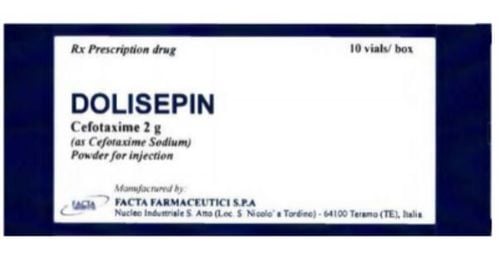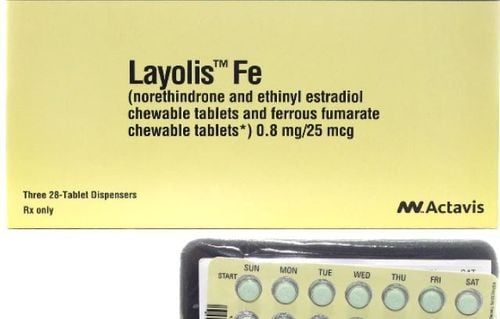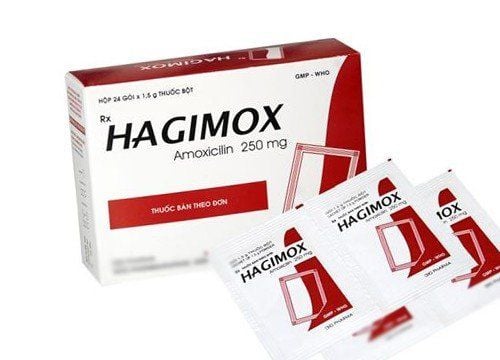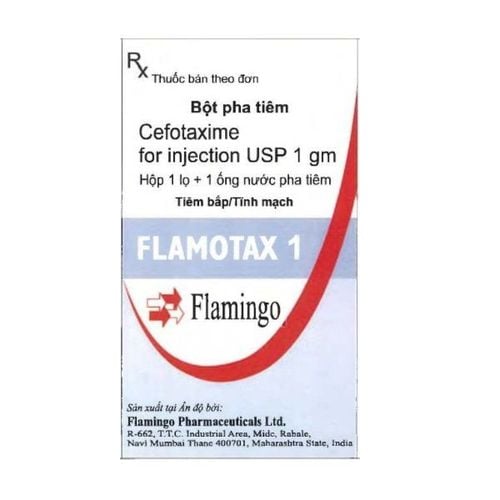This is an automatically translated article.
Zentotacxim CPC1 is a broad-spectrum antibiotic, indicated for the treatment of brain abscesses, bacteremia, endocarditis, gonorrhea and for the prevention of infection after prostate surgery.
1. What is the effect of Zentotacxim CPC1?
1.1. What is Zentotacxim CPC1? Zentotacxim CPC1 drug with registration number VD-18002-12, is a product manufactured by VCP Pharmaceutical Joint Stock Company. Zentotacxim drug has the main ingredient Cefotaxime (in the form of cefotaxime sodium): 1g. Zentotacxim CPC1 is prepared as a powder for injection, packed in a box of 10 vials, each containing 1g of the drug and 10 ampoules of distilled water for injection.
1.2. What disease does Zentotacxim CPC1 treat? Zentotacxim CPC1 is an ETC drug used to treat:
Brain abscess, (except meningitis caused by Listeria monocytogenes). Blood infection. Severe intra-abdominal infections (in combination with metronidazole). Pneumonia and inflammation of the endocardium. Gonorrhea . Prophylaxis of infection after prostatectomy including laparoscopic surgery and cesarean section. Contraindicated using Zentotacxim CPC1 in case: Patients with hypersensitivity to cephalosporins or lidocaine (if lidocaine solvent is used for intramuscular injection).
2. Usage of Zentotacxim CPC1
2.1. How to use Zentotacxim CPC1 The patient needs to carefully read the instructions on how to use Zentotacxim CPC1 that have been written on the instruction sheet. Do not arbitrarily use Zentotacxim CPC1 by other routes not stated in the instruction sheet.
Zentotacxim CPC1 is used by intramuscular injection, slow intravenous injection or intravenous infusion.
2.2. Dosage of the drug Zentotacxim CPC1 Adults: Usual dose: Use 2 to 6g, divided into 2 or 3 times. In severe infections, the dose may be increased to 12g per day, administered intravenously in 3 to 6 divided doses.
Children: Usual dose: Use 100 to 150mg/kg body weight/day. For infants is 50mg/kg body weight/day, divided into 2 to 4 times. If necessary, the dose can be increased to 200 mg/kg body weight/day. The maximum dose for infants is from 100 to 150 mg/kg body weight/day.
Renal impairment: The dose of cefotaxime should be reduced in patients with severe renal impairment (creatinine clearance less than 10 ml/min): After the first loading dose, the dose should be reduced by half, but the number of doses should be kept the same. medicine for 1 day. The maximum dose per day is 2g.
Treatment time: After the fever is gone, or when it is certain that all bacteria have been eliminated, the patient will take the drug for another 3 to 4 days. For the treatment of infections caused by group A beta-hemolytic streptococci, treatment must be administered for at least 10 days. Persistent infections sometimes require treatment for several weeks.
Treatment of gonorrhea: Use a single dose of 1g.
Prevention of infection after surgery: Inject 1g of Zentotacxim CPC1 30 - 90 minutes before surgery. In case of caesarean section, a dose of 1g should be injected into the mother's vein immediately after clamping the vegetable stalk and then 2 doses are injected into the muscle or vein after 6-12 hours.
Handling missed dose: In case the patient misses a dose of Zentotacxim CPC1 while taking it, take it as soon as possible (usually it can be taken 1-2 hours after the scheduled time). requested by the doctor). But, if it is too close to the next dose, skip the missed dose and take the next dose of Zentotacxim CPC1 at the scheduled time. Note that do not take double the prescribed dose, to make up for the missed dose.
Treatment of overdose: If during or after treatment with Zentotacxim CPC1 the patient has severe or prolonged diarrhea, the possibility of pseudomembranous colitis must be immediately thought of. severe digestive disorders. The patient should immediately discontinue Zentotacxim CPC1 and be replaced with another antibiotic clinically effective for C. difficile colitis (eg, metronidazol, vancomycin).
If there are symptoms of poisoning, it is necessary to immediately stop the drug Zentotacxim CPC1 and take the patient to the hospital for treatment. Peritoneal dialysis or hemodialysis may be used to reduce blood levels of cefotaxime.
3. Notes when using Zentotacxim CPC1
Before initiating therapy with Zentotacxim CPC1, the patient's history of allergy to cephalosporins, penicillins or other drugs should be thoroughly investigated. If concomitant use of Zentotacxim CPC1 has the potential to cause nephrotoxicity (eg, aminoglycosides), renal function should be monitored. Zentotacxim CPC1 may cause false positives in the Coombs test and other tests of urinary tract or reducing agents without the use of a method. Safety in pregnant women has not been established. If it is really necessary for patients to take Zentotacxim CPC1, please consult your doctor before using it, to be safe for the fetus. Zentotacxim CPC1 can be used with women who are breastfeeding, but care must be taken when the child has diarrhea, thrush or a rash. Patients must carefully weigh the benefits and risks before taking them. And should only be used when absolutely necessary. The literature does not indicate an effect of Zentotacxim CPC1 on the ability to drive vehicles and operate machinery and equipment.
4. Side effects of Zentotacxim CPC1
At therapeutic doses, Zentotacxim CPC1 was well tolerated. However, the process of using Zentotacxim CPC1, patients may still experience side effects such as:
Common: Diarrhea and thrombophlebitis. Uncommon: eosinophilia, leukopenia, change in gut flora: Pseudomonas aeruginosa and Enterobacter spp. Rare: Anaphylaxis, hypersensitivity, thrombocytopenia, agranulocytosis, hemolytic anemia, pseudomembranous colitis, and plasma liver enzymes. If experiencing these symptoms, the patient should stop using Zentotacxim CPC1 and notify the doctor for appropriate treatment.
5. Zentotacxim CPC1 . drug interactions
Zentotacxim CPC1 may have an interaction reaction if used concurrently with:
Cephalosporin and Colistin: There may be a risk of kidney damage; Cefotaxime and penicillin; The drugs ureido - penicillin; Probenecid ; To avoid interactions, before being prescribed Zentotacxim CPC1, the patient should inform the doctor about the drugs they are using, including functional foods. The doctor will base on that to prescribe the appropriate Zentotacxim CPC1.
6. How to store Zentotacxim CPC1
The shelf life of Zentotacxim CPC1 is 36 months from the date of manufacture. Store Zentotacxim CPC1 in a cool, dry place, at a temperature not exceeding 30°C, in the original packaging and protected from light, away from acidic environments. Keep Zentotacxim CPC1 out of reach of children and pets. Before using, should carefully review the expiration date of Zentotacxim CPC1. Absolutely do not use Zentotacxim CPC1 after the expiry date printed on the package. Above is all information about Zentotacxim CPC1, patients need to read carefully the instructions for use, consult a doctor / pharmacist before using. Absolutely do not arbitrarily buy Zentotacxim CPC1 treatment at home because it may encounter unwanted side effects.
Please dial HOTLINE for more information or register for an appointment HERE. Download MyVinmec app to make appointments faster and to manage your bookings easily.













